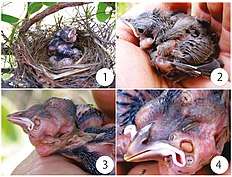Shrike-like tanager
The shrike-like tanager (Neothraupis fasciata), also known as the white-banded tanager, is the only member of the genus Neothraupis in the tanager family (Thraupidae), nine-primaried oscines of the Passeroidea.
| Shrike-like tanager | |
|---|---|
| at Alto Paraíso de Goiás, Goiás state, Brazil | |
| Scientific classification | |
| Kingdom: | Animalia |
| Phylum: | Chordata |
| Class: | Aves |
| Order: | Passeriformes |
| Family: | Thraupidae |
| Genus: | Neothraupis Hellmayr, 1936 |
| Species: | N. fasciata |
| Binomial name | |
| Neothraupis fasciata (Lichtenstein, 1823) | |
Distribution and habitat
It is a bird native to the interior of south-central South America at elevations of 550–1,100 m (1,800–3,610 ft). It is restricted to Cerrado, woodland and shrub of central-eastern Brazil, north-eastern Paraguay and north-eastern Bolivia. It is frequently seen in Chapada dos Guimarães, Mato Grosso, Brazil.
Description
Its plumage is remarkably similar to that of several species of shrikes in the genus Lanius, but these Corvoidea are quite distantly related songbirds. Males and females of this species look alike. It has a total length of about 16 cm (6 1⁄4 in) and weighs 29–32 g.
Behaviour
Typically seen in pairs or small groups of up to 12 individuals, with 7 being average. Eats insects. Breeds in October and November. The deep, cup-shaped nest, typically placed in a small tree or bush, is lined with grasses. Clutch size 2–3 eggs. The pair are often helped by birds from earlier broods, which have the grey parts of the plumage partially or entirely replaced by brown (this brownish plumage sometimes mistakenly referred to as the adult female plumage).

References
- BirdLife International (2012). "Neothraupis fasciata". IUCN Red List of Threatened Species. 2012. Retrieved 26 November 2013.CS1 maint: ref=harv (link)
- Pujol-Luz, José Roberto; Duca, Charles; Marini, Miguel Ângelo; Barbosa, Leandro; Couri, Márcia Souto; Pujol-Luz, José Roberto; Duca, Charles; Marini, Miguel Ângelo; Barbosa, Leandro (2018). "A new host for Philornis torquans (Diptera, Muscidae) from the Brazilian Cerrado". Papéis Avulsos de Zoologia. 58. doi:10.11606/1807-0205/2018.58.57. ISSN 0031-1049.
External links
- Photo – mangoverde.com
